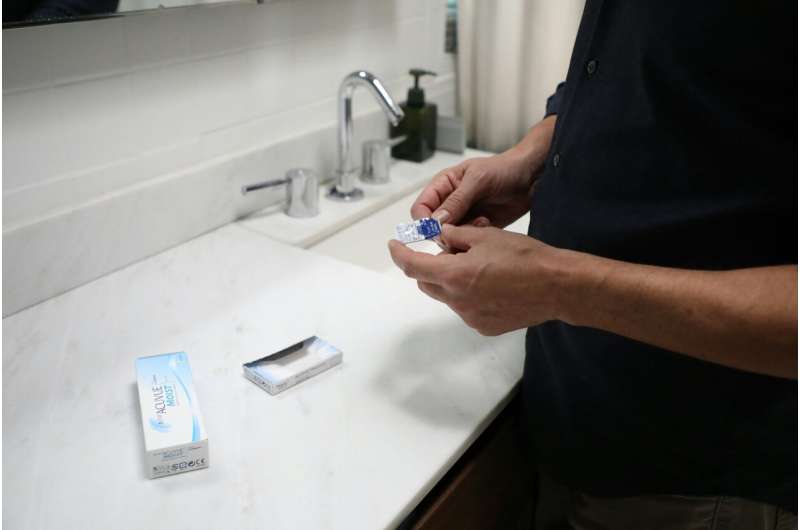This article has been reviewed according to Science X's editorial process and policies. Editors have highlighted the following attributes while ensuring the content's credibility:
fact-checked
trusted source
proofread
Organic compound found in trees could prevent contact lens eye infections

A new study suggests a naturally-occurring material is an effective disinfectant for contact lenses, worn by millions of people worldwide.
Microbial keratitis is one of the most serious potential complications for contact lens wearers. It's an infection of the cornea that is caused by bacteria; the most common being Pseudomonas aeruginosa.
Previous studies have found that existing disinfecting solutions are not effective for preventing biofilm, which are clusters of bacteria that attach to the surface of lenses.
Hydroquinine, an organic compound found in the bark of some trees, is known to have bacterial killing activity against Pseudomonas aeruginosa and several other clinically important germs, including Staphylococcus aureus, Escherichia coli, and Klebsiella pneumoniae.
The team behind the discovery, from the University of Portsmouth in England and Naresuan and Pibulsongkram Rajabhat universities in Thailand, has now explored the potential use of multipurpose formulas containing hydroquinine as a disinfectant for contact lenses.
They examined the antibacterial, anti-adhesion, and anti-biofilm properties of hydroquinine-formulated multi-purpose solutions (MPSs), and then compared it to two commercial MPSs; Opti-free Replenish and Q-eye. The natural compound killed 99.9 percent of bacteria at the time of disinfection.
The paper, published in Antibiotics, says these findings may aid in the development of novel disinfectants aimed at combating the P. aeruginosa bacteria.
Dr. Robert Baldock from the School of Pharmacy and Biomedical Sciences at the University of Portsmouth, said, "Commercially available disinfecting solutions, which are made up of a number of chemicals, can sometimes cause reactions with painful side-effects.
"We hoped to demonstrate that new agents made from natural products may be an excellent option to limit or reduce the risk of contact lens contamination.
"It is exciting to see how this research has progressed; from discovery to exploring potential applications."
There are up to 3.5 million reports of corneal infections annually, and in extreme cases it can result in permanent eye damage and vision loss. The risk of microbial keratitis doubles when someone wears contact lenses overnight and or longer than the recommended daily amount.
Corneal blindness resulting from microbial keratitis is emerging as a prominent cause of visual disability, according to the World Health Organization (WHO). The World Health Organization (WHO) has also classified multidrug-resistant P. aeruginosa as one of the most concerning pathogens.
Drug-resistant bacteria occur in more than 2.8 million infections and are responsible for 35,000 deaths per year. Antimicrobial resistance happens when germs change over time and no longer respond to medicines, making it difficult to treat infections.
Amoxicillin and Trimethoprim are commonly prescribed antibiotics that certain strains of P. aeruginosa have become resistant to.
Hydroquinine is already known to be an effective agent against malaria in humans, and it is also being used in the Netherlands to treat nocturnal muscle cramps. Until now, there has been little investigation into its drug-resistant properties.
Lead author, Sattaporn Weawsiangsang from the Faculty Of Allied Health Sciences at Naresuan University, is currently a visiting researcher at the University of Portsmouth.
She said, "Our initial findings suggest that soaking contact lenses in a multi-purpose solution containing hydroquinine is possibly helpful to prevent contamination and infection.
"However, further investigation is needed to determine whether hydroquinine itself also has adverse reactions or toxicity.
"We are continuing to test the compound on a number of cells, and so far, the results are really promising. This potential development could contribute to the creation of new disinfectants from natural products, effectively combating P. aeruginosa infections and reducing cases of corneal infections."
The paper concludes by recommending further research examining the effectiveness of hydroquinine with several different contact lens materials, and against other pathogenic microorganisms.
More information: Sattaporn Weawsiangsang et al, Hydroquinine Enhances the Efficacy of Contact Lens Solutions for Inhibiting Pseudomonas aeruginosa Adhesion and Biofilm Formation, Antibiotics (2024). DOI: 10.3390/antibiotics13010056





















